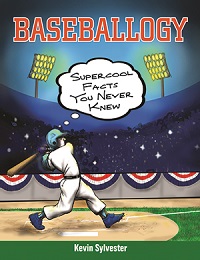| ________________
CM . . .
. Volume XXII Number . . . .September 25, 2015
excerpt:
Former radio broadcaster Kevin Sylvester will captivate baseball aficionados and casual sports fans alike with his highly entertaining and engaging book. Though most people might think of baseball as a fairly simple game of throwing, hitting and catching a ball, Sylvester explains, in an easy, conversational writing style, that it is actually quite complex, with math, physics and psychology coming into play. Sylvester discusses the history and evolution of the equipment- the ball, gloves, bats and helmets- as well as the various sizes of the playing field in different stadiums. Like any other sport, baseball is a business with money coming in through ticket sales, TV revenues, stadium rentals, concessions, and parking fees, and money going out for players’ and employees’ salaries, advertising, equipment, scouting and broadcasting. Accounting is just one area in which math is important in baseball. Math figures prominently in reporting plays on the field (e.g. a 7-2 out means that the leftfielder threw the ball to home for an out), assigned player numbers, batting and pitching statistics, records of single season and career home runs, and the seemingly unbreakable records of steals, wins, career strike outs and hitting streaks, to name just a few. Also included in the book is information about the post-World War II women’s league, suspensions and scandals in the sport (for instance, Pete Rose’s gambling on baseball and Mark McGuire’s use of performance-enhancing drugs), changes in the duration of the games and players’ salaries over the years, radio and television broadcasting of the games, stadium attendance records, and much more. In the chapter about pitching, readers will learn how to interpret the abbreviations in pitching stats as well as about the kinds of pitches, pitching speeds, the pitcher’s mound and the role of relief pitchers. Similarly, in the chapter about batting basics (ball speed, parts of the ball, and hitting), readers will learn how to interpret the abbreviations in batting stats. The section about freak injuries might elicit a few chuckles or shakes of the head from readers. For example, a player from the Detroit Tigers missed a whole series in the playoffs when he strained his wrist playing Guitar Hero, and a Milwaukee player dislocated his shoulder while attempting to rip a phone book in half. But the most amusing story involves a Red Sox player who would remove his false teeth and put them in his back pocket every time he played. In one game, he hit a double, slid into second base, and the teeth sank into his posterior. Throughout the book, there are baseball trivia, with one example being that, if a baseball ball were unraveled, its 337 metres of yarn would reach almost to the roof of the Empire State Building. Another example of trivia is that Babe Ruth once missed several games because of indigestion caused by his eating twelve hot dogs and drinking eight sodas between games. Colourful illustrations consist of drawings, graphs, charts, diagrams and a timeline, all perfectly suited to the text. A baseball trivia quiz, a table of contents and an index are also provided. Baseballogy: Supercool Facts You Never Knew is fun, educational and extremely interesting, and readers needn’t be huge baseball fans in order to enjoy it. This book hits it out of the ballpark. A home run! Highly Recommended.
Gail Hamilton is a former teacher-librarian in Winnipeg, MB.
To comment on this title or this review, send mail to cm@umanitoba.ca.
Copyright © the Manitoba Library Association. Reproduction for personal use is permitted only if this copyright notice is maintained. Any
other reproduction is prohibited without permission.
CM Home |
Next Review |
(Table of Contents for This Issue - September 25, 2015.)
| Back Issues | Search | CM Archive
| Profiles Archive |
